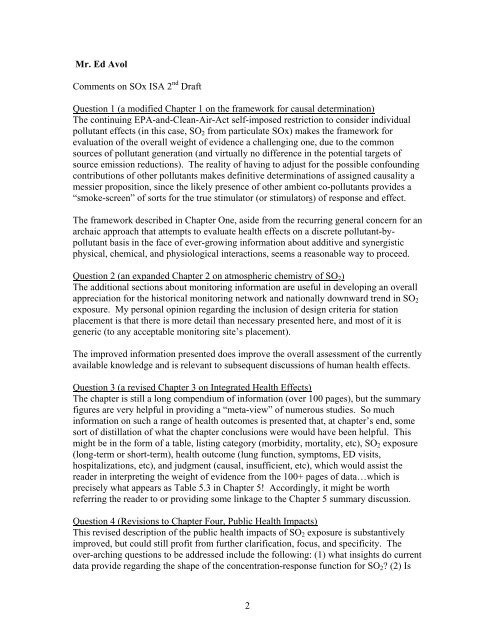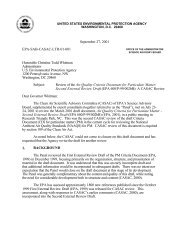(CASAC) Peer Review of EPA's Integrated Science Assessment
(CASAC) Peer Review of EPA's Integrated Science Assessment
(CASAC) Peer Review of EPA's Integrated Science Assessment
You also want an ePaper? Increase the reach of your titles
YUMPU automatically turns print PDFs into web optimized ePapers that Google loves.
Mr. Ed AvolComments on SOx ISA 2 nd DraftQuestion 1 (a modified Chapter 1 on the framework for causal determination)The continuing EPA-and-Clean-Air-Act self-imposed restriction to consider individualpollutant effects (in this case, SO 2 from particulate SOx) makes the framework forevaluation <strong>of</strong> the overall weight <strong>of</strong> evidence a challenging one, due to the commonsources <strong>of</strong> pollutant generation (and virtually no difference in the potential targets <strong>of</strong>source emission reductions). The reality <strong>of</strong> having to adjust for the possible confoundingcontributions <strong>of</strong> other pollutants makes definitive determinations <strong>of</strong> assigned causality amessier proposition, since the likely presence <strong>of</strong> other ambient co-pollutants provides a“smoke-screen” <strong>of</strong> sorts for the true stimulator (or stimulators) <strong>of</strong> response and effect.The framework described in Chapter One, aside from the recurring general concern for anarchaic approach that attempts to evaluate health effects on a discrete pollutant-bypollutantbasis in the face <strong>of</strong> ever-growing information about additive and synergisticphysical, chemical, and physiological interactions, seems a reasonable way to proceed.Question 2 (an expanded Chapter 2 on atmospheric chemistry <strong>of</strong> SO 2 )The additional sections about monitoring information are useful in developing an overallappreciation for the historical monitoring network and nationally downward trend in SO 2exposure. My personal opinion regarding the inclusion <strong>of</strong> design criteria for stationplacement is that there is more detail than necessary presented here, and most <strong>of</strong> it isgeneric (to any acceptable monitoring site’s placement).The improved information presented does improve the overall assessment <strong>of</strong> the currentlyavailable knowledge and is relevant to subsequent discussions <strong>of</strong> human health effects.Question 3 (a revised Chapter 3 on <strong>Integrated</strong> Health Effects)The chapter is still a long compendium <strong>of</strong> information (over 100 pages), but the summaryfigures are very helpful in providing a “meta-view” <strong>of</strong> numerous studies. So muchinformation on such a range <strong>of</strong> health outcomes is presented that, at chapter’s end, somesort <strong>of</strong> distillation <strong>of</strong> what the chapter conclusions were would have been helpful. Thismight be in the form <strong>of</strong> a table, listing category (morbidity, mortality, etc), SO 2 exposure(long-term or short-term), health outcome (lung function, symptoms, ED visits,hospitalizations, etc), and judgment (causal, insufficient, etc), which would assist thereader in interpreting the weight <strong>of</strong> evidence from the 100+ pages <strong>of</strong> data…which isprecisely what appears as Table 5.3 in Chapter 5! Accordingly, it might be worthreferring the reader to or providing some linkage to the Chapter 5 summary discussion.Question 4 (Revisions to Chapter Four, Public Health Impacts)This revised description <strong>of</strong> the public health impacts <strong>of</strong> SO 2 exposure is substantivelyimproved, but could still pr<strong>of</strong>it from further clarification, focus, and specificity. Theover-arching questions to be addressed include the following: (1) what insights do currentdata provide regarding the shape <strong>of</strong> the concentration-response function for SO 2 ? (2) Is2
















